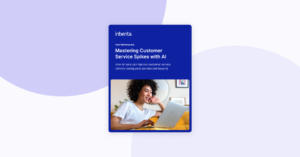A chatbot that speaks in your brand voice builds trust, consistency and a strong customer experience. Start by defining your brand’s tone, whether it’s formal or casual, and train your chatbot on it. Giver your chatbot an engaging persona and make it adaptable using Natural Language Processing (NLP). Train it on your brand’s data and use customer feedback to keep refining and improving it.
We all know what a bad experience with a chatbot feels like: robotic, impersonal and often just plain unhelpful.
With Conversational AI, chatbots that understand the nuance of language and context around a question can provide a more personalized — and more human — experience for customers.
But chatbots also represent your brand. So rather than using a generic voice, your chatbots should speak in your brand’s voice. In other words, they should sound like your human agents, so customers have a consistent experience across your support or sales channels — whether they’re talking to a person or a bot.
Why is brand voice so important? It can help create a bond and build trust with your customers. It can also set you apart from the pack. The challenge is ensuring your chatbots can adapt to different contexts and customer touchpoints while maintaining a consistent voice — all while providing a positive customer experience.
“Nearly 80% of American consumers say that speed, convenience, knowledgeable help and friendly service are the most important elements of a positive customer experience,” according to a CX report from PwC.
So with that in mind, here are a few tips to tailor your chatbot to your brand voice.
Top Tips to Tailor Your Bot
Define your brand voice
This is the tone and language that represents your brand. Is it formal or informal? Casual or professional? Humorous or authoritative? By understanding the ‘voice’ of your brand, you can integrate that tone and corresponding vocabulary into your chatbot interface. You can even integrate brand keywords and phrases into responses to reinforce your messaging (but don’t overdo it).
Make it engaging
While you want the chatbot experience to be consistent with your brand, you also want it to be engaging. That might mean giving your chatbot human qualities by creating a character or persona. For example, a company might use their mascot as a ‘character’ for their chatbot, complete with a backstory. There are several templates available online that can help you create this persona, from the chatbot’s name to their role and personality traits.
Make it adaptable
While you want your chatbot to incorporate the company’s brand voice, that voice should be adaptable, based on the context of the call. For example, maybe your brand voice is casual and humorous. But if a customer is upset, that may not be the best approach; rather, you might want a calm, empathetic tone. By incorporating Natural Language Processing (NLP) capabilities, your chatbot will ‘learn’ to understand the context of a conversation, broaden its response capabilities and improve its conversational skills.
Test and train
Before you launch a chatbot, you’ll need train it on data that represents your brand’s voice, such as marketing materials and social media posts. You can also use real-life examples of customer interactions and test responses to different types of queries to ensure they’re consistent with your brand voice.
Repeat
Once you’ve trained, tested and tweaked a chatbot, it’s ready for the real world — but testing and training doesn’t stop there. You’ll want to monitor its customer interactions for accuracy, relevance and consistency — not to mention brand voice. By soliciting customer feedback, you can refine your chatbot to continually improve and optimize the customer experience.
In brief:
- Integrate your brand’s tone into your chatbot responses using relevant keywords and phrases.
- Create a persona for your chatbot to make interactions more engaging, using templates if needed.
- Use Natural Language Processing (NLP) to help your chatbot adjust its tone based on context.
- Train and test your chatbot using your brand’s data to keep its responses consistent.
- Keep refining your chatbot based on customer feedback.











